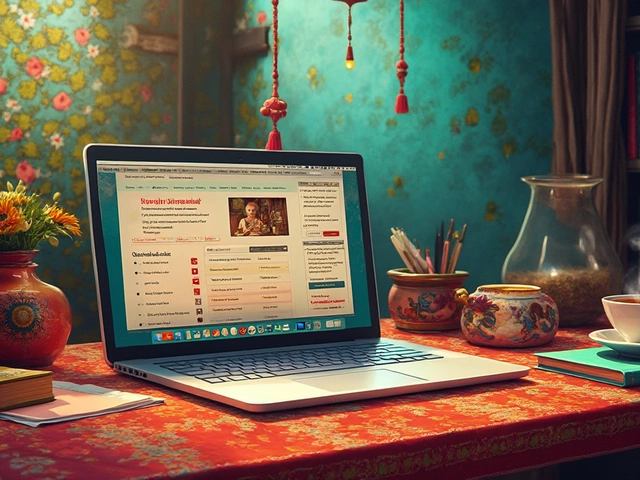Ever stare at all those fancy blogs and feel like you’ll never have one? Good news: you don’t need a tech degree or a fat wallet to start. All you need is a bit of curiosity and some free time.
The internet is brimming with free blogging platforms. Places like WordPress.com, Blogger, and even Tumblr let you sign up and start writing in minutes. No credit cards. No weird contracts. It’s literally as easy as making a social media profile, but you get way more freedom to say what’s on your mind.
What usually trips up new bloggers is the feeling that you need everything perfect before you begin. That’s a myth. You don’t need a logo, a polished “About Me,” or even a genius idea. The most important step is just… starting. Pick your blogging platform, sign up, and poke around. Every big name blogger was a newbie once.
- Choosing the Right Free Blogging Site
- Creating Your Blog Account
- Personalizing Your Space
- Writing and Publishing Your First Post
- Getting Your First Readers
Choosing the Right Free Blogging Site
This is where things get real. There’s a handful of solid free blogging sites out there, but not every one fits everybody. Picking the right one saves time and a lot of headaches down the road.
WordPress.com stands out for beginners who want lots of options. It’s basically the biggest name in the game. You get free hosting, a bunch of themes, and you don’t need to mess with code. But you do get a small ad on your site, and your blog address looks like yourblog.wordpress.com.
Blogger is owned by Google. Signing up is quick, especially if you already have a Gmail. It's easy to use, and you can even plug in Google’s free tools like Analytics and AdSense later. Your blog address ends with .blogspot.com. There aren’t as many design choices as WordPress, but it’s super straightforward.
Tumblr works best if you love short posts, images, memes, or want your stuff shared fast. It’s more social—people can follow you, like, and reblog instantly. It’s not for super long essays, but for quick updates and creative stuff, it’s perfect.
Wix and Weebly give you drag-and-drop power but don’t offer as much room to grow unless you pay. Their free plans slap their ads onto your blog, but if you want something that looks fancy and don’t care about a custom domain, they’re worth a look.
- If you want the most flexibility: go for WordPress.com.
- If you like things simple and connected to Google: pick Blogger.
- If visuals and quick sharing are your jam: try Tumblr.
- If you want drag-and-drop design: check out Wix or Weebly.
Let’s make it even easier. Here’s how these free blogging sites stack up side by side:
| Platform | Best For | Domain Structure | Free Plan Ads |
|---|---|---|---|
| WordPress.com | Flexibility, Growth | yourblog.wordpress.com | Yes |
| Blogger | Simplicity, Google Tools | yourblog.blogspot.com | Yes |
| Tumblr | Visuals, Quick Sharing | yourblog.tumblr.com | Yes |
| Wix | Design, Drag-and-drop | username.wixsite.com/site | Yes |
| Weebly | Design, Ease of Use | yoursite.weebly.com | Yes |
Don’t overthink it. You can move or switch platforms later, but picking a free blogging site that matches how you want to create makes starting a whole lot smoother.
Creating Your Blog Account
Ready to actually get your blog live? First thing you need to do is create your account on your chosen free blogging site. This is where most people hesitate but honestly, it’s just a few simple steps.
- Head to the site: Go to the homepage of the platform you’ve picked; WordPress.com, Blogger, or another. There’s usually a big, obvious button that says something like “Get Started” or “Sign Up.”
- Enter your details: They’ll ask for basics—email, a username, and a password. You don’t need to use your real name if you want to stay anonymous.
- Pick a blog name and URL: This part matters more than you think. It’s what people will see in their browser bar and what you’ll share. Try to keep it simple, short, and closely tied to your topic or nickname. Good news: if your first pick isn’t available, these platforms suggest similar ones automatically.
- Check your email and confirm: Most free blogging sites send a quick verification email to make sure you’re real. Click the link in that email and you’re set.
A cool fact: as of 2024, WordPress.com alone powers around 43% of all websites globally. That just shows how simple and fast it is to get started there.
One thing to watch for: most free platforms will give you a domain that ends with their brand, like “yourblog.wordpress.com” or “coolblog123.blogspot.com.” If you ever want your own custom domain, you’ll have to pay later on—but it’s totally fine to start with the free version.
Once you finish signing up, you’ll land on your fresh dashboard—the main control center for your new blog. This is where you’ll customize everything, post new articles, and track your site’s stats and traffic. Simple, right?

Personalizing Your Space
Getting your blog to look like “you” is the fun part. All the top free blogging sites give you loads of ready-made themes, so you don’t need design chops. On WordPress.com alone, there are more than 100 free themes, and you can swap them with a click—no HTML or coding needed.
Stick to something simple in the beginning. When folks land on your site, you want them to read your words, not get blinded by colors or lost hunting for the subscribe button. Classic layouts with clean fonts and one or two accent colors work best. Platforms like Blogger and Wix let you preview themes live, so you see changes before they hit your public blog.
Add a profile photo and a mini bio. This puts a face and personality behind your posts, making you more approachable. If you’re feeling shy, use an avatar or a photo of something you love—pets work surprisingly well.
Here are a few actions to make your space unique without spending a dime:
- Choose a theme: Click around until one feels right. It’s super easy to change later.
- Edit your blog’s title and tagline: These pop up in search engines, so use words related to what you’ll write about (“Easy recipes for students,” not just “My blog”).
- Set up core pages: Most bloggers start with an About page and a Contact page. These don’t have to be fancy—just say who you are and how readers can reach you.
- Tweak your sidebar: Add social media links, a short intro, or a list of your favorite posts. Every blogging tip out there says sidebars make navigation easier for your readers.
According to a 2024 survey from FirstSiteGuide, two out of three new bloggers say they spent less than an hour picking and tweaking their initial blog theme. So, don’t stress trying to make things “perfect.” You can always update your look as you go—it’s part of the fun.
Writing and Publishing Your First Post
This is the moment most people get hung up. Staring at a blank screen can be intimidating, but trust me, nobody writes a masterpiece on their first try. You just need to hit publish once to get the ball rolling. The secret? Focus on what’s actually important to you, not what you think people want to read. Realness grabs attention way more than being polished.
On just about every free blogging site, once you log in, you’ll usually spot a button labeled “New Post,” “Write,” or even a plus (+) sign. Click that and a simple editor pops up, looking kind of like a Word document. Don’t worry about fancy formatting right now. Just type your thoughts.
- Give your post a clear title. Make it descriptive so people know what to expect—"Why I Decided to Start a Blog" or "3 Things I Learned This Week" works way better than something vague.
- Keep your first few paragraphs short and punchy. It’s easier for you to write and readers to follow.
- Add a photo if your platform lets you. Most readers pause longer on blogs with images (according to Orbit Media, blogs with images get over 90% more views).
- Preview your post before you hit publish. Most blogging tips will tell you to catch typos or weird formatting. If it looks readable on your phone and computer, you’re good.
- Now, just click “Publish.” Seriously, that’s it. Your first post is live for the world.
Worried about readers not showing up right away? That’s normal. Even top bloggers started with zero views. The key is to keep writing. Set a simple goal for yourself—one post a week is plenty.
Here's a quick peek at how some popular free blogging sites handle post publishing so you know what to expect:
| Platform | New Post Button | Photo Upload? |
|---|---|---|
| WordPress.com | "Write" on Dashboard | Yes |
| Blogger | "New Post" | Yes |
| Tumblr | Plus (+) Sign | Yes |
Your first post doesn’t need to go viral. It’s all about breaking the ice and finding your own style. As you write more, you’ll figure out what feels right for you—and that’s when blog setup gets really fun.

Getting Your First Readers
This is the part most new bloggers worry about. Nicely designed blog? Great. But if nobody shows up, it feels like shouting into the void. The good news is, getting your first set of eyes isn’t rocket science, even if your budget is zero.
The first move is to share your blog posts on your personal social media. Don’t overthink it—just hit share. Your friends and family are honestly your best first readers. You’d be surprised: a 2024 survey by Statista showed that 78% of people discover new blogs through social media links. Facebook, Instagram Stories, and even your LinkedIn can be quick traffic boosters if you drop your link with a casual comment like, "Just launched my new blog—would love your feedback!"
Next up: join communities. Every new blogger should find a few places to hang out where folks already chat about their interests. Reddit, Facebook Groups, Discord servers—there’s a spot for everything. But don’t just spam your link. Talk to others, drop your blog only where it makes sense, and always follow the group rules.
- Answer questions on Quora or Reddit that relate to your blog topics, and add your link if it’s helpful.
- Comment on other blogs in your niche—real comments, not just “great post!” (Use your blog name when you fill in the “Website” box—it counts as a link back.)
- Network with other new bloggers; swap links or guest posts to boost each other's reach.
If you want to sneak in some extra power for Google, pick a main topic for your blog and sprinkle those words into your posts and titles. Blogs that focus on a topic (like travel, food, or tech) snag search traffic faster. Google likes it when you stick to what you know.
Here’s what works best for most beginners, based on recent free blogging case studies:
| Traffic Source | Beginner-Friendly | Expected Early Visitors (per month) |
|---|---|---|
| Social Media Sharing | Yes | 30-200 |
| Participating in Online Communities | Yes | 10-100 |
| Search Engines (SEO) | Can take time | 5-20 initially |
Don’t feel bad if things move slow at first. Every popular blogger started with just one or two readers (usually their mom). Keep posting, keep sharing, and your audience will grow—promise.



